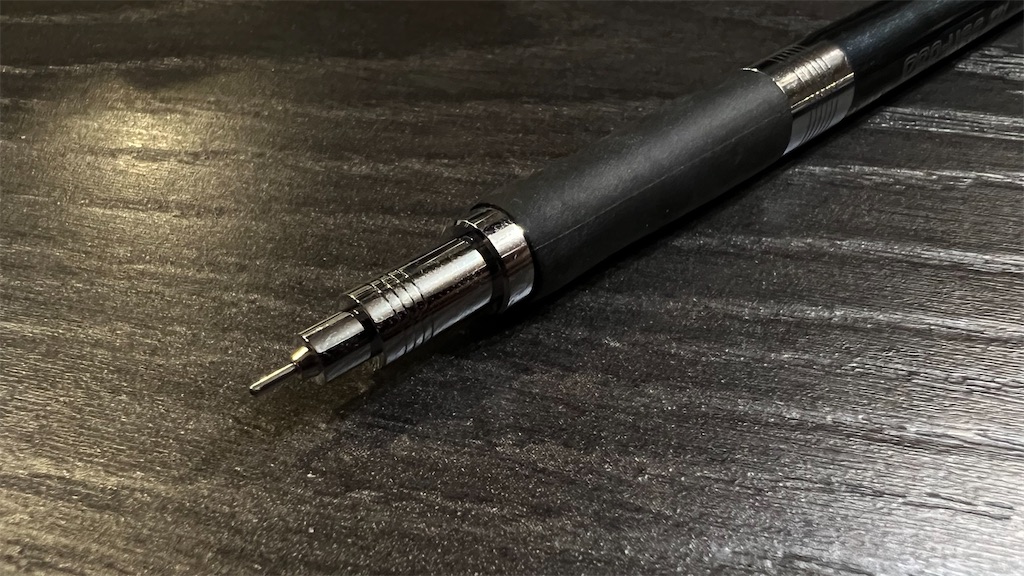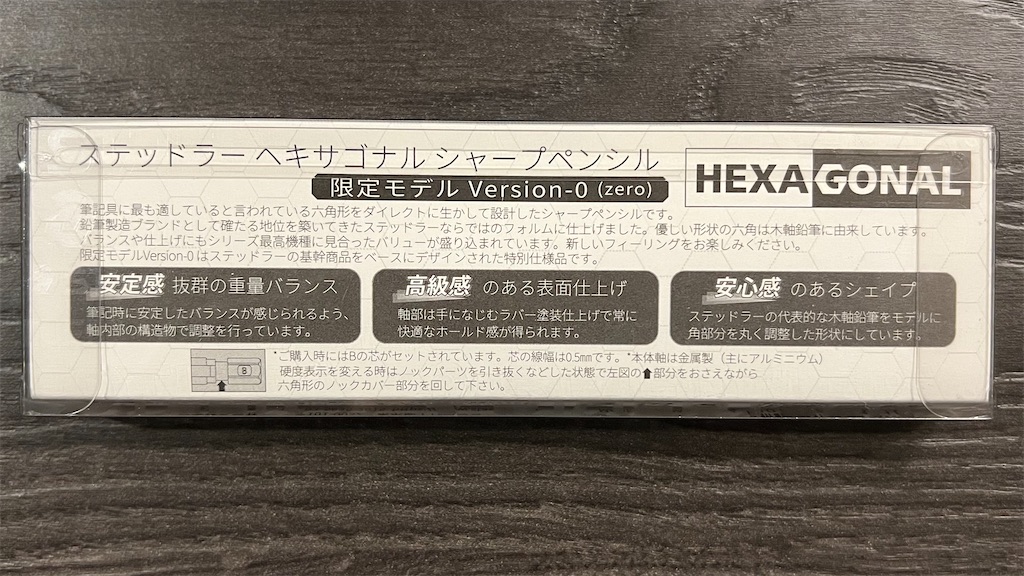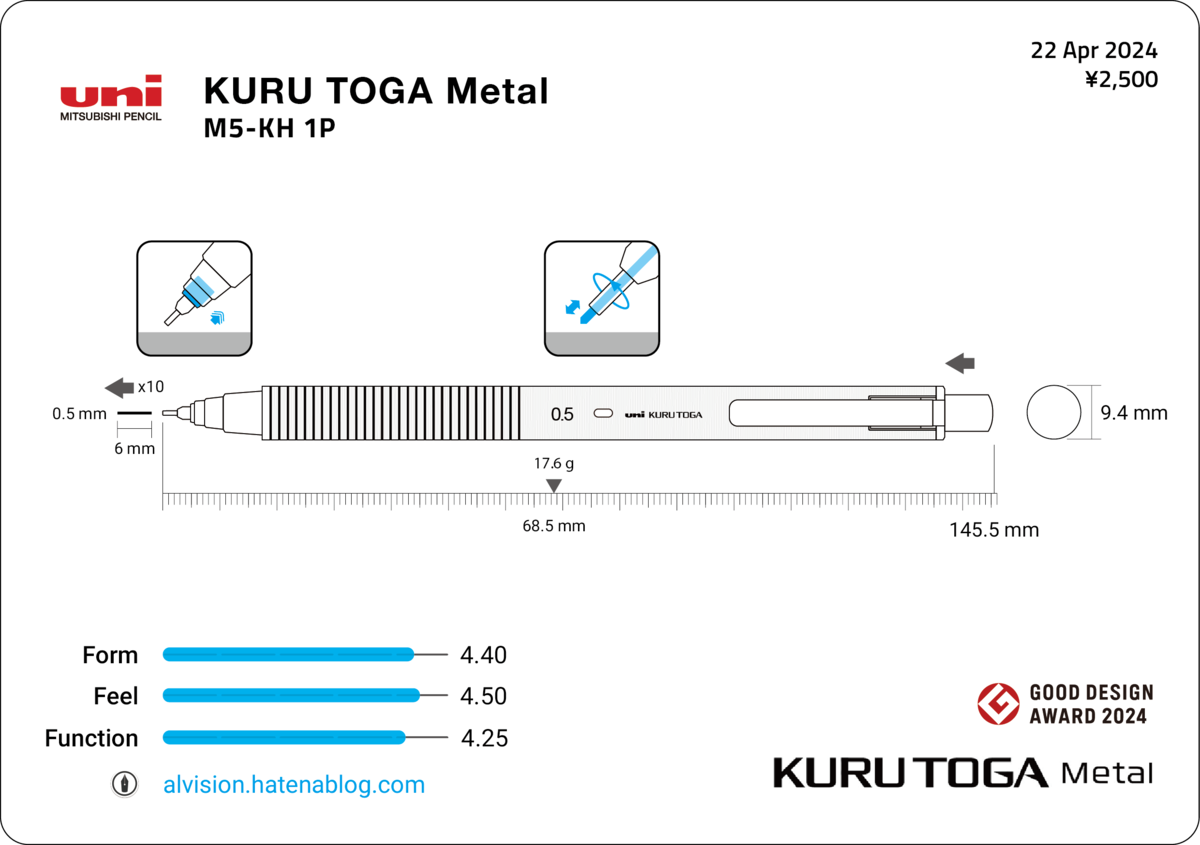PRO-USE 241 is the latest addition to PLATINUM's PRO-USE family, a long line of drafting mechanical pencils "made for professionals".

Early Models
The earlier PRO-USE models were much like other drafting mechanical pencils, featuring long lead sleeves, grippy grips, lead grade indicators, and multiple lead sizes. The lineups range from MSD-300, MSD-500, MSD-1000, MSD-1500, and MSDB-1500 (originally MSD-1300, a color variant of MSD-1000), where the numbers are also their prices in Yen.

The obvious oddity in this bunch is the MSD-1500, nicknamed ツチノコ after the mystic creature for its stubby proportion, and it's probably going to be as hard to find as the ツチノコ in a decade or two. I hope to write a full review of it some day, for now I'll just say this: get it while you still can, get a spare too, if you can afford it.

A New Beginning
In 2017, PLATINUM released the MSDA-1500, or PRO-USE 171, which is quite different from its predecessors, in both appearance and features.

PRO-USE 171 has a knurled grip that's separated from the barrel. It resembles more to the likes of STAEDTLER 925 85 or OHTO PROMECHA 1000P, and is no less gimmicky.
The knurled grip, and an actuator near the cone, act as switches (named as one "Snork Mechanism") that provide adjustability and flexibility for those who also want the option to use the drafting pencil for more general purposes such as writing.

We now know it as the progenitor of a new generation of PRO-USE mechanical pencils, but for the longest time I thought the odd numbering 171 was just a one-off thing. It's not until the release of PRO-USE 231 (MSDC-1500) and PRO-USE 241 (MSDD-2500) 7 years later that a new branch in the PRO-USE family tree starts to take shape.
Numbering System
*For simplicity I'll omit the prefix PRO-USE and just refer to the new family members by their numbers.
Prior to the release of 231 and 241, it wasn't clear to us average consumers why the PRO-USE series has such a messed up numbering system, where most models only have the prefix MSD while 171 and the black variant of MSD-1000 have a four-letter prefix MSDA and MSDB, yet the limited variants of 171 still carry the prefix MSDA.
Now it's more apparent that each new model (excluding color variants) after 171 advances the 4th letter by one alphabet. And it's also announced officially that "The first two digits of the three-digit number in the product name indicate the year of release, and the last digit is counted up each time a derivative model is released."
So say if they released a second PRO-USE in 2024 priced ¥3,000, it would be named PRO-USE 242 and be given the model number MSDE-3000.
It would be easier to visualize with a table:

PRO-USE 231

Compared to 171, which was advertized as a drafting pencil that can also be used for writing, 231, considering the timing, the apparent delay, and the limited nature, seems more like an experimental run to bring in the mechanisms from their other mechanical pencil line—OLEeNU, a series of pencils focused on protecting the lead against breakage.

So far, I counted roughly 7 different mechanisms spreading across the OLEeNU family, such as OLEeNU Shield, OLEeNU Guard, or ZeroShin. The ones implemented on the 231 are the OLEeNU Guard mechanism, which protects the lead within the cone, and the Pipe Slide mechanism, which allows the sleeve to slide out in use and be stowed away when not.

Not too impressive when compared to its predecessors. The same can be said about its form. The lanky pencil features a stepped cone and a rubber grip. More reasons to suspect it as a pilot run or testing stone for the real deal—PRO-USE 241, which PLATINUM announced as "a further enhanced model of PRO-USE 171", thus declaring 241 as the true heir but also confirming 231 as a partially enhaced model of 171.
PRO-USE 241

Form
Announced only a few months after the release of 231, 241 shares a striking resemblance to 171, to the point where one might mistake one for the other. A bit disappointing, but not entirely a bad thing since 171 is quite a good looking pencil. I, for one, appreciate it when good design traits are passed to the next generation. In that regard, the elongated 231 was a failed mutation, looking more like a chimera of PRO-USE and OLEeNU.

Like 171, 241 has a knurled grip, a conical cone, and an actuator ring in between that adjusts the sleeve (more on that later). The main difference being that, instead of one uninterrupted surface, the knurling is broken up into 9 segments by thin grooves. The actuator ring has the same knurling instead of the grooves on 171, and now looks more like an additional segment of the grip. Personally, I find the whole chromed surface a bit too dazzling, and despite the toothy look I find them not as grippy as I prefer my knurled pencils to be. The traction they provide is comparable to OHTO SUPER PROMECHA's knurled grip.

The upper halves of 171, 231, and 241 are almost identical, made up of the same old plastic barrel, a chromed metallic clip, and a grooved end cap with a lead grade indicator. The end caps look very similar but are not fully interchangeable.
The PRO-USE logo and the iconic cushion switch guide remain unchanged, but the lead size (only available in 0.5) is now more prominently printed, keeping to the design first seen on the limited Matte Black 171.

I say cushion switch "guide" because the label doesn't indicate the state of the switch. There's no way to tell whether the cushion is on or off without actually testing it or trying the switch, or we just have to remember how we set it last time. I was hoping PLATINUM would add some sort of indicator to make this more user-friendly. Other pencils with this type of switch (such as ZEBRA Tect 2way or uni α-gel SWITCH) usually have an indicator for users to immediately read off the position.
The guide itself is also not immediately clear whether we should turn the barrel or the grip. You should hold the grip in place and turn the barrel right (counterclockwise) to activate cushioning.

Another trait inherited from the limited editions is the metallic lead reservoir, a major upgrade over the original 171 which still uses plastic tubes.
The position and length of the clip also remain unchanged, unfortunately. A design flaw in my opinion, as the upraised tail of the clip would constantly brush over or dig into my skin while I rotate the pencil to keep the tip sharp.

Function and Feel
Now comes the fun stuff.
All the functional upgrades in 241 seem to lie within the first 2 cm of the pencil. These include the OLEeNU Guard parts, a sliding sleeve, and the new knurled actuator to lock or release the sleeve.

Basically, PLATINUM kept the cushion switch on 171 and replaced the gimmicky sleeve-covering feature with a lockable sliding sleeve. Mixing sleeve-sliding with lead-cushioning creates some interesting effects, and with 2 independent on/off switches, we get a total of 4 different modes, advertised on PLATINUM's special page for 241 as:

I've simplified it down to:

The idea is great, but how is the execution? I went through each of the four modes writing this review on a wooden table. The pencil is quite heavy, weighing close to 26 g, but balances well with a low center of gravity. The writing feel is different in each mode. Let's go over each mode in detail, starting from the bottom up.
Tech Drawings (OFF/OFF)
By turning both cusion and sliding off, we get the most stable writing experience, and the feedback from the tip was very satisfying. I don't do technical drawings, but from my experience it writes at least as well as some of the better drafting pencils, including early models in the PRO-USE series. When the mechanisms are turned off, the parts are truly locked in place. There was no tip wobbles whatsoever despite all the moving parts involved.
I wish I could say the same about the other end of the pencil. The lead tube and the end cap rattle against the barrel as I write, ruining the solid writing experience. This has been a problem since 171 and I'm surprised PLATINUM still has not addressed this issue after 7 years.
Sketches (OFF/ON)
In their table, PLATINUM listed this mode as equivalent to their PRESS MAN, the 0.9 mm mechanical pencil made for journalists who write in a rush with a heavy hand.
Supposedly, the cushion sacrifices some precision for the protection against inadvertent lead breakage. However, turning the cushion on didn't change the experience for me personally, because I never write with a lot of force. Even when I deliberately write harder or faster, the cushion mechanism rarely activated.
So maybe it's a good idea for those like me to just leave the cushion turned on at all times as a sort of "air bag" for the lead.
Quick Notes (ON/OFF)
Rotating the sliding switch raises or lowers the front piece, which includes the cone and the sleeve. When it raises to the top, the sleeve is locked in place, and when it lowers to the bottom, the sleeve is released and can slide back, allowing the user to continue writing after the exposed lead is used up, with the sleeve retreating as more lead is worn away.

One slight inconvenience is that the lead does not move with the front piece. So when you lower the front piece to release the lead sleeve, the lead is mostly likely still in the "raised" position. Another knock is required either before or after turning the switch on, otherwise the sleeve will just slide back in. Also, 241's sleeve is designed not to retract all the way in, so we only get about 2 mm of extra lead with each knock.

One of the smoothest sliding sleeve mechanism is without a doubt the one on a Pentel orenz. We're not even supposed to write with the lead exposed, because the sliding sleeve is also there to protect the lead so it never breaks. The tip of the sleeve is rounded off so it doesn't feel scratchy. No such luck with 241 though. I could immediately feel the scratchiness when the sleeve "touches down" on paper. Hopefully over time it will be rounded off with use.

Taking all these into account, I guess this mode is really only suitable for those who can't pause their writing for even the briefest of an instant to advance the lead. In such case I think a ballpoint pen might be a better option.
Long Essays (ON/ON)
Lastly, we turn both switches on.
This is what I've been looking forward to testing ever since I saw the press release and the keyword "Hayaai" in there.
A bit of background: Hayaai is a series of discontinued pencil from the '80s—also made by PLATINUM—that featured the POINT PUSH-MATIC mechanism. It is not an automatic mechanical pencil as the name may suggest, but has a convenient way to get more lead exposed by pushing the tip (or point) down on the paper or the desk.

The cushioning and sliding mechanisms on these pencils allow the lead and sleeve to be pushed up. The lead would return to its original position when lifted while the sleeve remains at the pushed-in position, thus exposing more lead to write with. This can be repeated 5 times per knock, until the sleeve is completely submerged.

A few other pencils also have this feature. In fact, I believe all mechanical pencils with a sliding sleeve and cushioning can achieve this feat. Still, I was excited to see a discontinued feature make a return to PLATINUM's dwindling line up of mechanical pencils.
The result on 241 is... mixed. I wrote the second half of this review entirely in this mode, and I think this is the most useful and comfortable mode to write with. The hidden POINT PUSH-MATIC feature does work, but because the sleeve does not go all the way in, there's only about 1.5 pushes' worth of extra lead to play with. The writing experience is excellent, at least while it lasted, but then it does last longer than any average pencils, for most users that should be more than plenty for one writing session.
I said "hidden" because there's no mention of this hybrid feature explicitly on PLATINUM's press release or the special page for 241 (no, as of November 2024 there's still no dedicated product page for this pencil, or 231 for that matter). I wonder why that is. Clearly they do want us to make the connection by naming the mechanism "Hayaai", but for some reason doesn't seem to want to attract too much attention to it.
Summary
Despite the design flaws and half measures: a slippery grip, a missing indicator, a scratchy tip, a sliding sleeve that doesn't fully retract, and an inner tube that rattles, PRO-USE 241 is still a substantial improvement over its predecessor PRO-USE 171.
In my opinion, two of the four modes are actually useable. I would keep both switches turned ON for writing, and both turned OFF for drafting. This achieves what PRO-USE 171 claimed but didn't fully achieve seven years ago. If only they could fix some of the long-overdue issues, this would have been a powerful 4-in-1 tool pencil.
Imagine having a STAEDTLER 925 35, a PLATINUM PRESS MAN, a Pentel orenz, and a rOtring rapid PRO in one pencil!

My overall rating for 241 is 4.1 (and 3.2 for 231). The pencil had great potentials, and performs well in some modes, but had too many unaddressed issues that lowered the score.
As usual, I've made an infographic card to sum up the specs.


















































